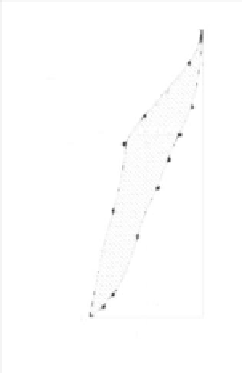Image Processing Reference
In-Depth Information
∗
(i
2
/a
2
− 1)), b
∗
(i
2
/a
2
− 1)),
where b
l
(a) = max
i
(y
i
/
u
(a) = min
i
((y
i
+ 1)/
a
∗
(1 + i
2
/b
2
)) and a
∗
(1 + i
2
/b
2
)).
€
l
(b) = max
i
((x
i
−1)/
u
(b) = min
i
(x
i
/
We conclude this section after offering an example.
Example 5.6. Consider a canonical hyperbola with a
o
= 10.5 and b
o
= 8.5
which is truncated at x = 20. D
o
X
= {11,11,11,12,12,13,14,15,16,17,18,
19,20} and D
Y
= {2,4,6,7,8,9,10,11,12,13}. After convergence of the I R
algorithm we get a
l
= 10.2618834,a
u
= 10.7322793,b
l
= 7.7711441,b
u
=
8.8987359. For this hyperbola, the domain of digitization is computed using
Theorem 5.10. The domain is diagrammatically presented in Fig. 5.6.
FIGURE 5.6: The domain Dom(D
o
) of an hyperbola for a
o
= 10.5, b
o
= 8.5,
and truncated at x = 20.
5.5 A Restricted Class of Digitized Planar Curves
In the previous sections we addressed the reconstruction problem of conics
in canonical form. We employed an iterative refinement technique to find close
bounds and the domain of the parameters for these geometric objects. The
success of I R as a general methodology for solving the reconstruction problem
for a diverse class of geometric objects has led to characterizing the properties
of the class of digital curves where I R may be fruitfully applied. In this section,
we develop an algorithmic scheme that utilizes some general properties of the
function representing the curve to solve the reconstruction problem. Moreover,

















